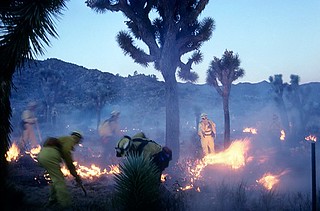The wildfire firefighting workforce: Is there a scarcity of trained firefighters to meet current needs?
by Emily Irving
It is a worry some may not want to think about. The 2021 fire season has already led to three of the largest California wildfires on record. But staff shortages in local, state, and federal fire departments pose a serious concern as fire sizes increase across the state. Aside from supply shortages, there appears to be an increasing threat of understaffed fire departments. This year’s Dixie Fire is already the largest single wildfire in California’s history, at a time when firefighter shortages are higher than ever. With these increasing wildfires, how do the numbers in the fire workforce compare? And what is the cause of these specific staffing shortages, especially for key leadership roles?
Why have firefighting positions decreased?
A report from Stateline finds that supervisory positions, such as squad leaders, are getting harder to fill. A 2019 American Community Survey reports an estimate of 48,246 first-line supervisors of firefighting and prevention that are full-time, year-round compared with an estimate of 297,645 firefighters working full-time in the U.S. With a large number of vacancies in skilled labor, this could leave fire crews with under-experienced supervisors. The data from these reports predicts that the skilled-labor workforce in all of the U.S. will continue to drop, and this could affect fire protection services especially. With a shortage of equipment such as fire hoses already, a shortage of trained supervisors could further harm firefighting services against growing wildfires.
A factor that shouldn’t be ignored is the effect the pandemic has had on staffing. In a KPBS interview, the president of the San Diego County Fire Chiefs Association pointed out that things such as schooling and internships were put on hold along with the rest of the world once COVID struck. So there are many employees in training or in the middle of their education who simply are not able to move up to a position of being hired. This would logically result in fewer skilled people to fill these positions. Coupled with an increase in retirements, fewer and fewer people are trained and ready to take on become supervisors on fire crews.
What solutions exist?
Thankfully, in an effort to address this staffing shortage, efforts from the government and local fire departments and fire protection associations are being put into place. According to Quick Response Fire Supply’s blog site, efforts underway to encourage younger and more diverse people toward careers in fire safety, such as targeted outreach using video messages, training programs (some that can be tuition free!) and internship programs.

Marin County and Santa Rosa Junior College, both in the North Bay Area of California, are introducing innovative programs for a workforce development pipeline. (More on this in an upcoming blog post!)
The Biden Administration also stated that seasonal employees will be permitted to properly train and equip more federal workers according to a report from CPR news.
Though a shortage of essential fire protection workers could spark panic, efforts to make up for the lessening of skilled positions and the pause in hiring are already underway.
Who is fighting these wildfires?

In the United States, wildfires are fought by local fire departments, state agencies, the federal government, private contractors, crews of incarcerated people who have been specially trained, and many times teams from other countries. The system is complex and often hard to track. State, local and federal crews routinely cross state lines to suppress major fires via an interagency system for mutual aid.
Federal: Federal firefighters work for federal government agencies such as the National Park Service, U.S. Fish and Wildlife, and the Bureau of Land Management. They are responsible for handling wildland fires and structural fires such as fires in industrial or residential buildings. Their positions can be permanent full time or seasonal and temporary jobs.
State: State firefighters work for their specific state government. For example, Cal Fire is the California State Firefighter department. They are responsible for protecting state residents, resources, and property.
Inmate Firefighters: The inmate firefighting program, or Conservation Camp Program, dates back to before WWII, and is only open to those incarcerated individuals who are physically capable and have 'minimum custody' status. Camp inmates are trained via the State fire agency, and not only battle blazes on the front line but also work as support and maintenance staff at the camps, serving as cooks, laundry workers, landscapers, and water treatment plant operators.
Local: Local firefighters serve in local fire stations within a certain town or district. Their responsibility is to provide fire rescue, medical services, and respond to emergencies within the specific city they are in.
Volunteer: Volunteer firefighters perform most of the same tasks as a local firefighter, but they devote their time for free to help out their local department. They receive the same training and help out saving lives and putting out fires, but do so while usually holding a separate, paid job.
Private Crews: Private firefighters have similar responsibilities as state firefighters but are not hired by the state. They are hired by private or insurance companies to perform fire protection on the homes of clients or commercial buildings.
Interagency/Mutual Aid: Many states have partnerships with federal agencies to provide wildfire suppression services through cooperative fire protection agreements. These agreements authorize federal and state partners to share resources—such as aviation equipment and personnel—during a wildfire season, allowing for a coordinated interagency response that deploys resources to areas of greatest critical need.

About the Author:
Emily Irving is a student at Sonoma State University and works as an intern for After the Fire: Recover. Rebuild. Reimagine.
Sources
Sophie Quinton. “Lack of Federal Firefighters Hurts California Wildfire Response”. Stateline Article. PEW. July 14, 2021. https://www.pewtrusts.org/en/research-and-analysis/blogs/stateline/2021/07/14/lack-of-federal-firefighters-hurts-california-wildfire-response.
Tania Thorne. “Local Fire Departments Suffering Staff Shortages”. KPBS. 3 September, 2021. https://www.kpbs.org/news/public-safety/2021/09/03/local-fire-departments-staff-shortages.
“#304 – A Skilled Labor Shortage is Looming in Fire Protection ITM”. QRFS. https://www.qrfs.com/blog/304-a-skilled-labor-shortage-is-looming-in-fire-protection-itm/.
“2019 American Community Survey (ACS), 1-Year Estimates”. United States Census Bureau. https://data.census.gov/cedsci/table?q=ACSDT1Y2018.B24124&tid=ACSDT1Y2019.B24124&hidePreview=false.
“Stats and Events”. Cal Fire. https://www.fire.ca.gov/stats-events/.
Joe Wertz. “As Wildfires Get Worse, So Are Firefighter Shortages. Climate Change And Low Pay Aren’t Helping”. CPR News. 1 July, 2021. https://www.cpr.org/2021/07/01/colorado-wildfires-climate-change-firefighter-shortage-pay/.
Alicia Victoria Lozano. “'In desperate need of these programs': California to close inmate firefighting training center”. NBC News. 6 June, 2021. https://www.nbcnews.com/news/us-news/desperate-need-these-programs-california-close-inmate-firefighting-training-center-n1269570
